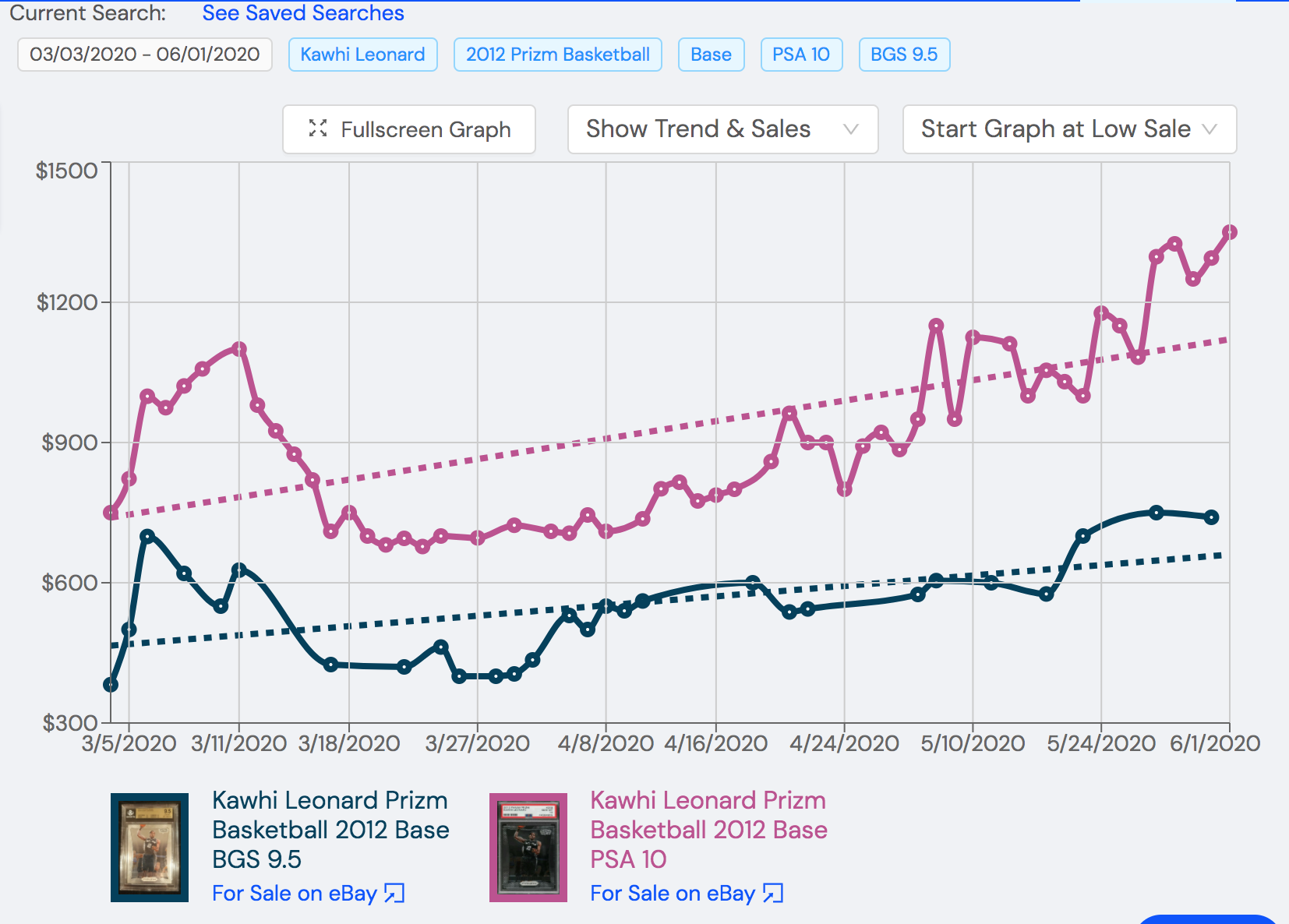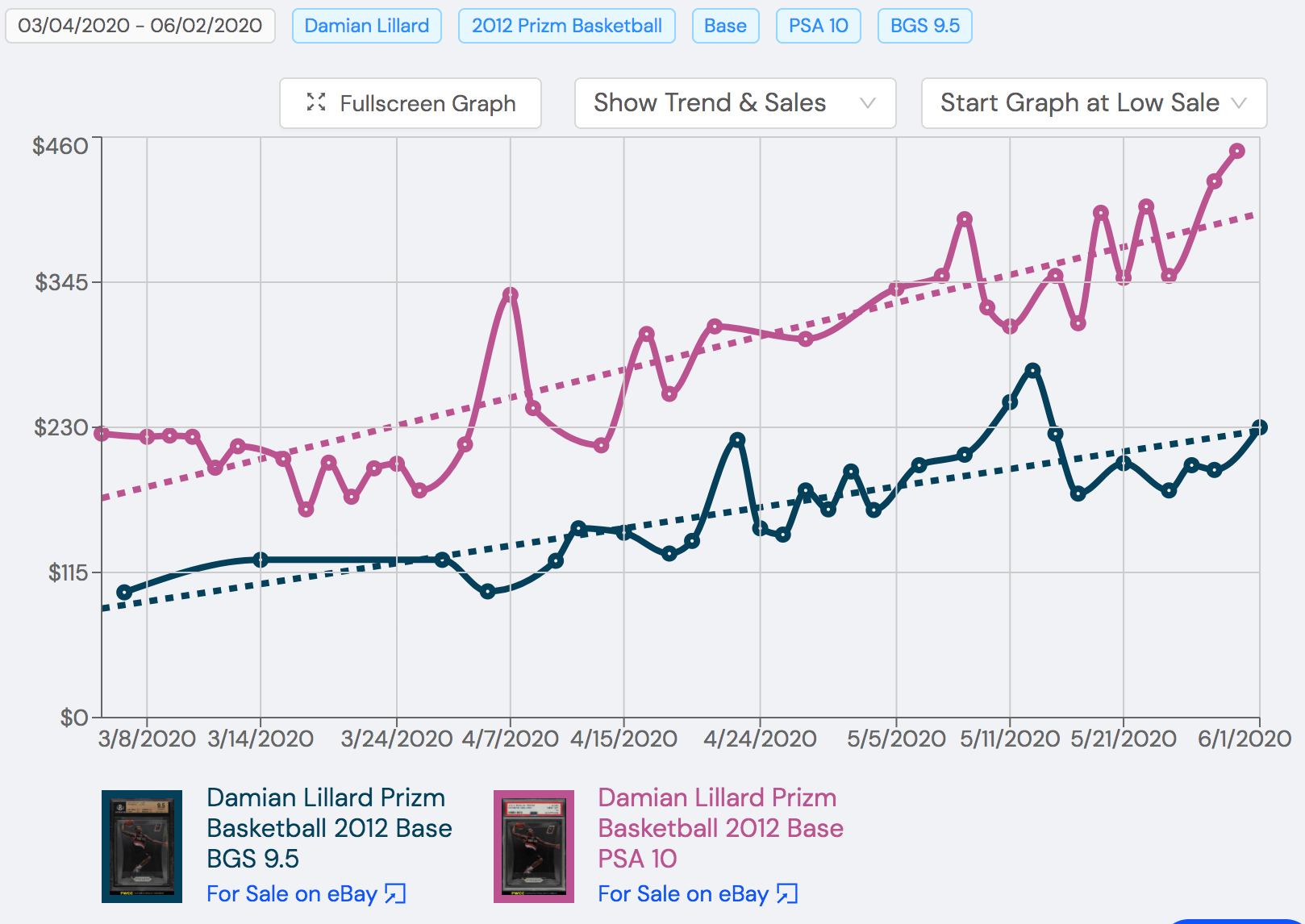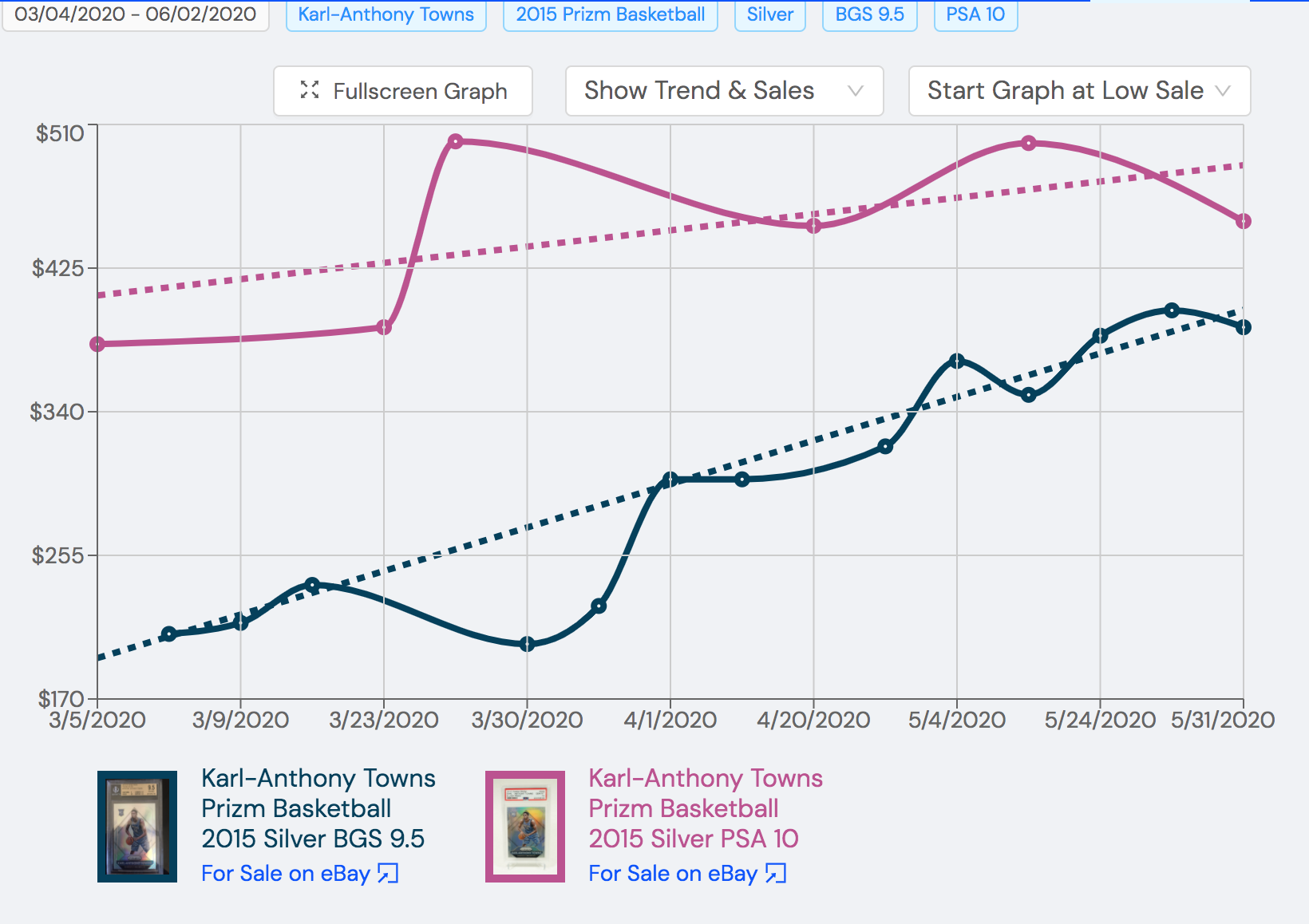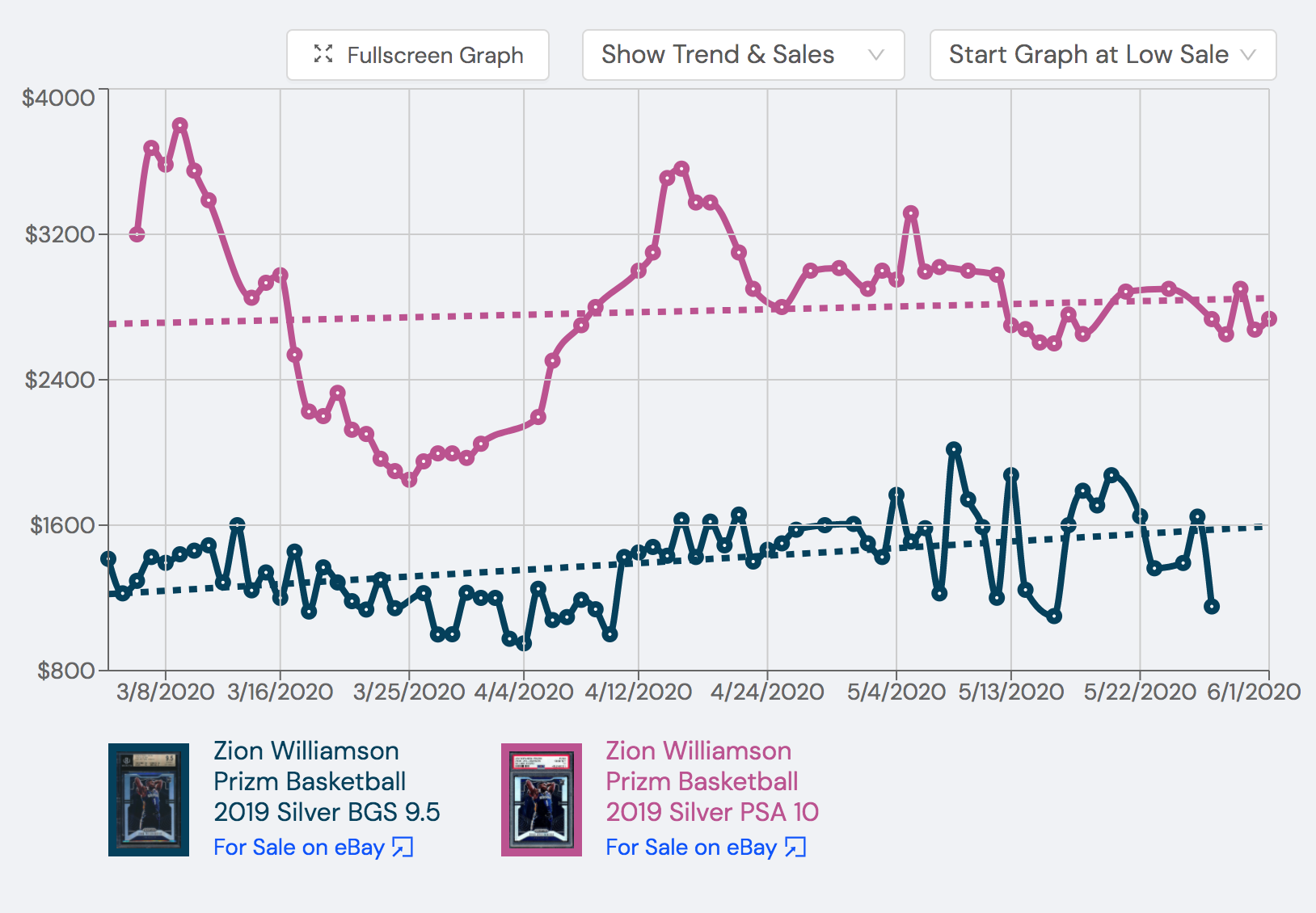Sports Card Investing - Targeting Graded NBA Cards
One thing that I’ve noticed since getting back into the Sports Card Investing market is that there are lots of ways you can exploit inefficiencies for profit. One of the inefficiencies I’ve noticed is the discrepancy in pricing between BGS 9.5 and PSA 10 graded versions of the same card.
Grading is an important part of the Sports Card Investing process. Grades help to increase the scarcity of a card. We’re always on the hunt for rare cards because the rarer the card, the easier it is for demand to overwhelm supply and force the prices higher. A grade is assigned to a card when the owner of the card sends it into a grading company like Beckett (BGS) or Professional Sports Authenticator (PSA). BGS and PSA are currently the most popular grading companies. They grade cards on a scale of 1 to 10 based on the condition of certain aspects of the card including corners, edges, centering and surfaces. The higher the grade your card receives the more valuable the card becomes.
One big difference between the two grading systems is that BGS uses subgrades which can include scores measured by .5 whereas PSA does not use the decimal. This makes it very difficult to score a perfect 10 on BGS, since a card has to be flawless in order to earn a 10. PSA has high standards to earn a 10, but since they do not have the sub grades it is easier to earn a 10 than with BGS. In other words, a BGS 9.5 could potentially score a PSA 10.
Why does this matter? Because PSA 10-graded cards tend to sell for significantly higher prices than BGS 9.5. This might open the door to target a BGS 9.5 card which can be submitted to PSA in hopes it would score a 10. Today we will be looking at some popular NBA players and examine the discrepancy between their BGS 9.5 and PSA 10 Panini Prizm sales using SportsCardInvesting.com’s Market Movers charts to illustrate the comparison. To do these types of comparisons on your own, sign up for a subscription today using the promo code: ROTOGRINDERS to receive 20% off your first payment on any subscription (you’ll want the Market Movers subscription in order to access the charting tools). Just like DFS, be sure to manage your bankroll and don’t spend more than what your budget allows. When targeting BGS 9.5 cards try to find the highest subgrades possible. BGS will list 4 subgrades on their label so you want to get the version of the card with the highest subgrades to improve your chances of converting the card to a PSA 10. If you can find a card with four 9.5s or three 9.5s and a 10 that would be a good one to target?

Sports Card Investing – Targeting Graded NBA Cards
Company Disclaimer: We may be compensated by the company links provided on this page
Kawhi Leonard – First up we’ll look at Kawhi Leonard Prizm rookie cards. Kawhi was drafted in 2011, but due to the NBA lockout his rookie cards were pushed to 2012. As you can see in the chart below, the PSA 10 version of his Base Prizm card is currently selling for significantly more than the BGS 9.5 ($1,350 vs $740). Additionally the chart illustrates that recent prices on the PSA 10 have been moving up a little faster than BGS 9.5 so the gap is widening. This might create a good opportunity to target the BGS 9.5 cards to add a more-affordable Kawhi rookie to your portfolio.

Chart Courtesy of SportsCardInvestor.com
2012 Kawhi Leonard Base Prizm PSA 10
2012 Kawhi Leonard Base Prizm BGS 9.5
Damian Lillard – Next up we’re going to stick with the 2012 rookie cards and look at Damian Lillard. Lillard has been mentioned a few times recently in our content so I figured his cards would be perfect for this list. His 2012 Base cards are still cheap going for $449 for a PSA 10 vs $230 for a BGS 9.5. You can pretty much buy 2 BGS 9.5s for the price of one PSA 10 which makes this extra tempting just to load up on BGS cards at these prices.

Chart Courtesy of SportsCardInvestor.com
2012 Damian Lillard Base Prizm PSA 10
2012 Damian Lillard Base Prizm BGS 9.5
Anthony Davis – The #1 pick of the 2012 draft, Anthony Davis, has a good likelihood of picking up his first ring playing with LeBron on the Lakers. He has an opportunity on his current team to seal his legacy and the value of his rookie cards. His Base Prizm rookie cards seem pretty cheap in general, most recently selling for $778 for the PSA 10 and $449 for the BGS 9.5.

Chart Courtesy of SportsCardInvestor.com
2012 Anthony Davis Base Prizm PSA 10
2012 Anthony Davis Base Prizm BGS 9.5
Karl-Anthony Towns – We’ll bump up to the Prizm Silvers for KAT’s rookie analysis. We see something a little different compared to the other players on this list. Towns’ BGS 9.5 sold most recently for $390 vs his PSA 10 which most recently sold for $452. This gap is nowhere near as wide as the nearly-2x gaps we’ve seen with other players. This has me wanting to target KAT’s PSA 10s in anticipation of a run up of those prices.

Chart Courtesy of SportsCardInvestor.com
2015 Karl-Anthony Towns Prizm Silver PSA 10
2015 Karl-Anthony Towns Prizm Silver BGS 9.5
Zion Williamson – Finally we’ll look at a comp for a more recent card, the 2019 Zion Williamson Prizm Silver. Zion’s cards have been pretty flat recently so if you’ve been waiting on an opportunity to pick up his Prizm Silver, the BGS 9.5 cards might be presenting you with an opportunity. As we can see from the chart provided by Market Movers, Zion’s PSA 10 most recently sold for $2,735 more than 2x the most recent BGS 9.5 sale of $1,153.

Chart Courtesy of SportsCardInvestor.com